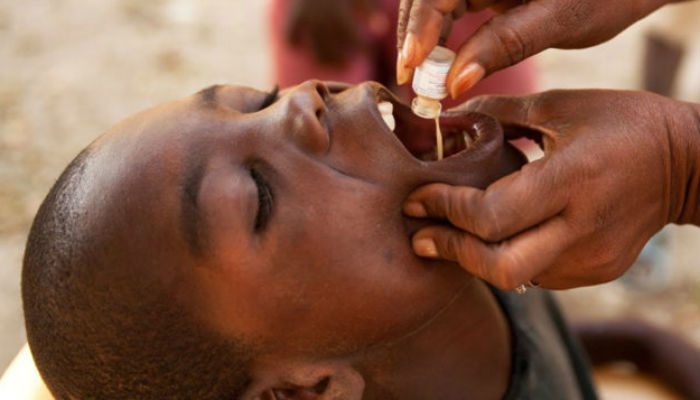I grew up seeing posters shouting “Kick Polio out of Kenya” in the early 2000s. These posters bore different images of children walking with crutches or using wheelchairs or children receiving oral polio vaccine drops. Some had the sketch of a child kicking a ball out of Kenya. The campaign in Kenya was part of a continental “Kick Polio out of Africa” campaign and the global polio eradication efforts.
In public health programmes goals, according to the Centre for Disease Control (CDC), there are two targets; Eradication and Elimination of diseases. Eradication refers to the reduction to zero or a low defined target rate of new disease cases in a defined geographical area. Elimination means that there is a complete and permanent reduction to zero new cases of Freedisease globally through deliberate efforts.
On 25 August 2020, the Africa Regional Certification Commission certified Africa as being free from wild polio. This certification was possible after four years without a new case of the disease in the continent, and more than 95% of the continent’s population immunised against the virus.
Nigeria was the last African country to be certified as being polio-free after a robust vaccination campaign in the face of political conflicts, insecurity, and opposition to the vaccine.
According to the World Health Organisation (WHO), Afghanistan and Pakistan are the only countries globally that continue to see wild poliovirus cases. This makes the dream of a polio-free world two countries away.
In a statement on the World Health Organization’s website, the WHO Director-General Dr Tedros Ghereyesus stated, “Ending wild poliovirus in Africa is one of the greatest public health achievements of our time and provides powerful inspiration for all of us to finish the job of eradicating polio globally.”
Two of the three wild polioviruses have been eradicated, and only wild type 1 poliovirus (WPV1) remains. Wild poliovirus type 2 was declared eradicated in 2015, and type 3 was declared eradicated in October 2019, according to the Global Polio Eradication Initiative (GPEI). Africa was certified to have eradicated the remaining WPV1 in its population.
Vaccination
Polio can only be prevented through vaccination, and there is no cure for the disease yet.
There are two types of vaccines:
- Oral Polio Vaccine (OPV)- developed in 1961 by Albert Sabin. It is alive but weakened virus vaccine, with the three poliovirus types. After three doses, it gives 95% lifelong immunity.
However, the OPV carries the risk of causing vaccine-derived poliovirus infection.
- The inactivated polio vaccine (IPV)- developed in 1954 by Dr Salk. It is a killed virus vaccine administered by intramuscular injection. It does not carry any risk of vaccine-derived infection because it is a killed virus vaccine, but there is a need for booster vaccinations for lifelong immunity.
Immunity to one type of poliovirus does not produce immunity to the other types.
Kenya
Kenya was certified Polio free in 2005, with the last confirmed case of poliomyelitis being reported in 1984. There has been the risk of imported cases from Somalia, but that was quieted when Somalia was declared polio-free in 2014.
The ministry of health reported vaccine-derived poliovirus in Kenya in 2018, though.
Vaccine-derived disease.
While the wild poliovirus has been eradicated in Africa, there are still cases of type-2 circulating vaccine-derived poliovirus (cVDPV2) in the continent.
Once the weakened oral polio vaccine is given, the weakened virus is shed in the stool and may mutate and cause infection in under-immunized children populations where sanitation is poor. While this is rare, there are campaigns to continue vaccinating children against the virus to eradicate it.
What is Polio?
Polio is a disease caused by the poliovirus and is also called poliomyelitis. The poliovirus is transmitted through eating or drinking foods and water contaminated with fecal matter from an infected person (feco-oral transmission).
The virus belongs to the virus family “enteroviruses” that survive the corrosive hydrochloric acid in the stomach. The virus enters the bloodstream and may then infect cells of the central nervous system. 90% of infected persons are asymptomatic, but infection may lead to either:
- A minor illness, called abortive poliomyelitis, is seen in 4-8 people in 100 with Polio. The nerves are not affected, and they have flu-like symptoms.
- Infection of the meninges (meningitis) without paralysis- 1-2% of Polio infections
- Flaccid paralysis. 1% of all Polio infections. This paralysis usually lasts the period of illness, and many patients recover.
- Paralytic polio- This is the major illness, affecting 0.1-2% of infected persons.
The virus may affect nerves either in the spinal column, part of the brainstem (bulbar polio), or both the spinal column and brainstem (bulbospinal polio).
- Death- this follows paralytic polio when muscles that aid breathing are affected. According to the Centre for Disease Control, 2-10% of people with paralytic polio die.
This certification is a strong testament to the importance of vaccines in disease prevention. It brings a smile to our faces amid the COVID-19 pandemic. I believe if we could, Africa would utter a resounding ululation to celebrate this moment.
Remember, vaccinating your child will protect them from this disease.











